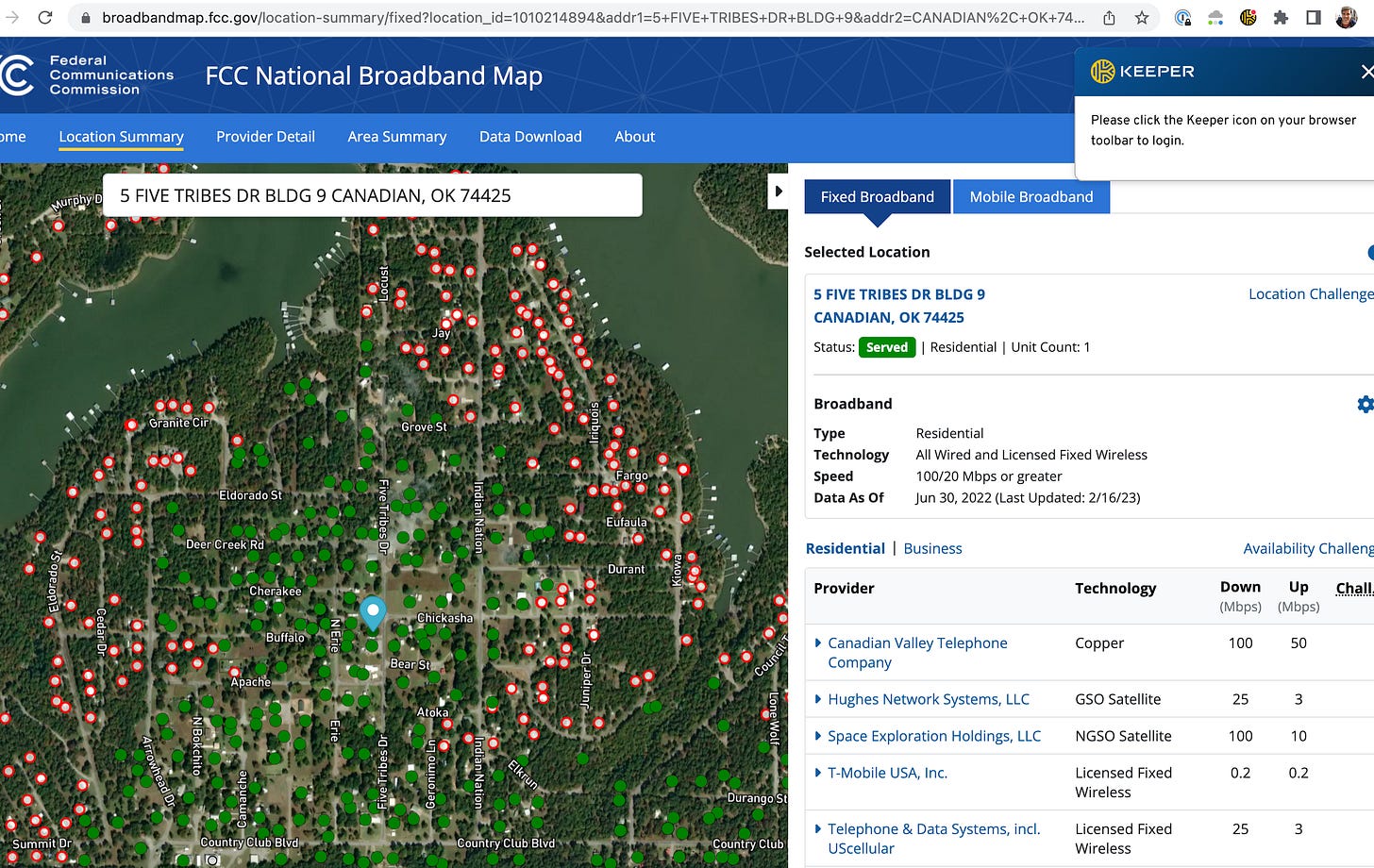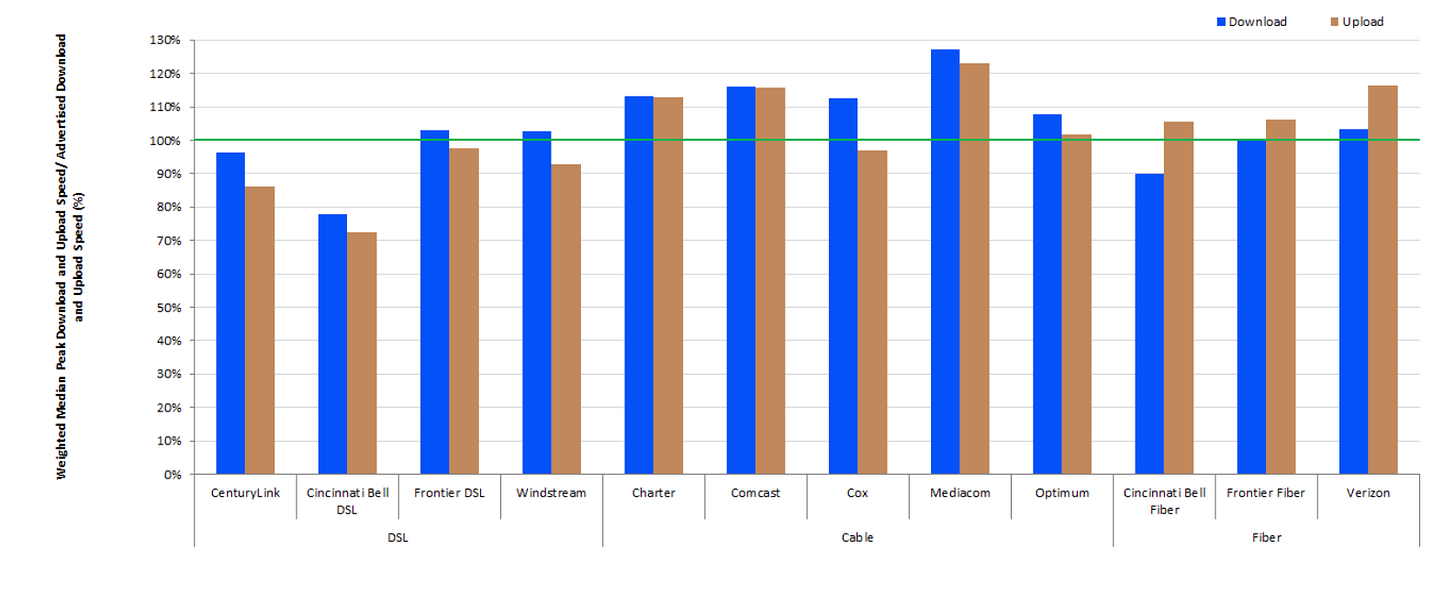State challenge processes are not a panacea for broadband map issues
Evan Feinman, NTIA’s BEAD Director, made headlines last week for comments that pointed out states can do their own challenge processes. That isn’t breaking news since states are guaranteed that right in the Infrastructure Bill. Still, there appears to be a narrative developing that displeasure with the FCC and the Map will be rectified once the process is in the hands of the states. To the states: careful what you wish for. I think there’s an easier way: states could choose to award grants in an technology-aware manner, adding 3.1 million locations currently Served or Underserved by DSL or 25/3 fixed wireless, which would have the same — or an even better — effect.
Let me explain. There are 218,878 locations where a DSL offering is advertising 100 Mbps download throughput and 20 Mbps upload throughput or better, and there is no other offering to the location that would serve them at 100/20. Do we need a lengthy challenge process to determine that these locations should get upgraded service? I certainly don’t think so.
Here are a couple random examples. First is a town on the Choctaw Nation tribal lands in Oklahoma. The provider here claimed 100/50 DSL in the center of the town and 50/25 on the outskirts.
Next is a home outside Crockett, Texas. Windstream claimed 123/52. As an aside, they only claimed 10/1 to the not-actually-locations nearby (second picture). Here’s a link to a spreadsheet with more random examples for anyone that wants to dig in further. Just plug in the location_id at the end of the URL: https://broadbandmap.fcc.gov/location-summary/fixed?location_id=1297077328
The original NTIA BEAD Notice of Funding Opportunity imagines this exact scenario where a state will want to exclude DSL wholesale:
NTIA acknowledges concerns that, in some cases, DSL arrangements fail to provide consistent access to advertised speeds. To the extent a particular location is identified on the Broadband DATA Maps as served by DSL at speeds that warrant treatment of that location as “served” or “underserved” but is not in fact reliably served at such speeds, this would be a proper basis for challenging the relevant location’s service status during the challenge process created by the Eligible Entity.
Let’s turn next to fixed wireless. In particular, offerings that were filed at 25/3 exactly, of which there are more than 2 million. I’ve written about this extensively on this blog, and there has been increasing coverage lately which is great. Specifically, there are 5,028,004 locations that are Underserved according to the official definition. About 40% of those, 2.1 million, would be Unserved if not for an “offering” at 25/3 on the number, which are mostly fixed wireless. I’ve posted many examples before so I won’t post more, but here’s 50 random examples if anyone wants to look for themselves.
So, final answer: while it would be unfortunate if states aren’t allocated funding based on these numbers, I think it would be fair to their residents if we consider (1) anyone served only by DSL, or (2) Underserved by a 25/3 offering to be eligible for a broadband upgrade with this generational funding opportunity. That’s the chart below. It takes us up from 7.8 million Unserved to 10.8 million Unserved, and actually lowers the Underserved from 5 million to 2.3 million (because so many became Unserved). It’s technology-aware and it’s fair.
It’s probably too late for this exact scenario to come to pass in the allocation (though I’m holding out hope something will get fixed at least with 25/3 fixed wireless), but let’s see what would happen as an exercise. Since the allocation is done based on the number of Unserved, the states with the largest number of locations Unserved but for a 25/3 offering stand to gain the most. That’s Iowa and North Carolina. Even if some states are “winners” and some aren’t, this is fair. Iowa and North Carolina should issue grants for these locations, and their funding should reflect that.
The other interesting question is how would it affect our ability to reach Unserved and Underserved locations with the available $42.5 billion, assuming the allocation formula goes ahead as planned. My previous estimate is we can reach at least 76% of them nationally. This approach changes that number almost not at all - less than a percentage point of difference. Unserved and Underserved is a distinction without a difference, so I’ve been grouping them together. This approach is similar: 13 million Unserved and Underserved locations, an increase of only 219,000 over the official BEAD definition.
State Level Challenge Processes
If we take the technology-aware approach, we should think critically about the pros and cons of state challenge processes. Once DSL and some fixed wireless locations are eligible for BEAD, the “pro” of a state challenge process would be to provide a path to including locations served by cable, which I’ll argue below introduces mostly risk. On the “con” side, we have the potential to seriously run off the rails.
It’s easy to lose sight of it, but the Unserved and Underserved represent a small piece of the country — 87% of American households have access to one or more fiber or cable offerings. If DSL and some fixed wireless locations were eligible for grants, we’d have most of the remaining 13% in the BEAD program. Thus, the locations that might be affected by a challenge process would be cable offerings. A successful challenge to a cable offering would take one of two approaches: 1) the cable service is not offered to the address, or 2) the service can’t deliver the maximum advertised throughput (I’m allergic to the word “speed” in this context because I believe speed means latency).
If service isn’t offered at the address, that should be an easy successful challenge. Usually the provider website will have a lookup tool. If the provider doesn’t offer service, it returns an “unavailable” message that should be enough evidence to submit the challenge. (Admittedly if providers are in the habit of contesting every challenge it makes things needlessly difficult). I’d recommend states have an accelerated challenge process for cases when service is unavailable at an address, and those challenges are also fed to the FCC for inclusion in the National Map.
Challenges of the maximum advertised throughput are much trickier. Nearly every cable offering — 98% of them — is considered Served at 100/20 or better. That means that a subscriber should be able to get 100/20 service at their router if they pay for it. The crucial question is: are they?
The FCC’s Measuring Broadband America report suggests yes. The MBA methodology tests ISPs from the consumer router against servers that are outside the ISP’s network. It’s a direct test of whether the throughput that’s promised is delivered. Almost all of the cable providers exceed the promised throughputs.
By contrast, consumer “speed tests” aren’t measured from the router. I’m concerned the two methods are not apples-to-apples. Consumer “speed tests” generally are initiated by the consumer on their devices — a laptop or phone usually connected over WiFi. There are lots of interesting ways analysts are trying to take out WiFi and other effects from these speed tests. One approach is taking the maximum throughput test result in a given area and using that as the available throughput. Or, we can try to take out test results that had a bad WiFi signal, though that data isn’t available on all tests. Still, it’s not apples-to-apples with a router-initiated test, and I’m not aware of research that has provided a method for making them equivalent.
If speed tests are allowed, the maps they produce of eligible locations have the potential to add millions of locations currently served by cable into BEAD. All of a sudden the 13 million Unserved and Underserved locations could be multiples of that. (If anyone would like to work with me to analyze a map of proposed eligible areas based on speed tests, I’d be happy to do that). My math — and others’ — that suggest we can essentially close the Digital Divide evaporates as locations that are Underserved by DSL compete with locations that have become “Underserved” by cable. If cable service is adequate broadband that’s delivering 100/20 now, and we still go down this road — disaster.
I want more competition for broadband in the U.S. as much as anyone else. But that isn’t what the BEAD program is intended to do. BEAD is intended to be the first real Internet offering for a household. If NTIA lets states “overbuild” cable, there are going to be some seriously angry U.S. Senators.
There are other possible ways state challenge processes could go awry. Running a challenge process is not easy — just ask the FCC. One complicated issue is how to apply successful challenges to larger areas. It’s intuitive that if a consumer challenge proves an ISP’s service doesn’t reach one house, then it also probably doesn’t reach the neighboring houses. Putting that into practice is much more difficult. DSL decays over long distances, and a cable provider may have overstated coverage, but how do we know what the actual service area is?
I’ve been told that I’m not clear enough about what my recommendations are. So here it is. My recommendations are:
States should fight like heck to get more of these DSL and 25/3 fixed wireless locations counted in the allocation. There’s some momentum. Press.
Even if they aren’t counted in the allocation, use a technology-aware formula to make DSL and 25/3 fixed wireless eligible for grants. Your residents will thank you.
Try to get through the state challenges as fast as possible. Make an easy process to report locations where service is not available at all, because that isn’t easy enough in the FCC process.
But don’t get hung up on speed test challenges to cable. With DSL and 25/3 fixed wireless as eligible locations, you’ll have captured the problem areas.











Another interesting approach - the Public Service Commission in South Carolina has declared that DSL is no longer considered to be broadband.